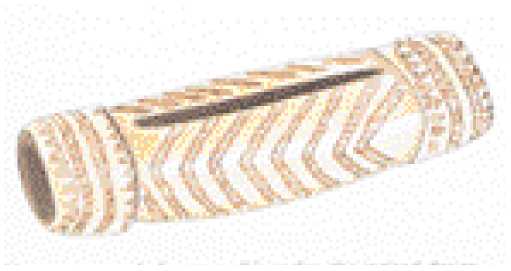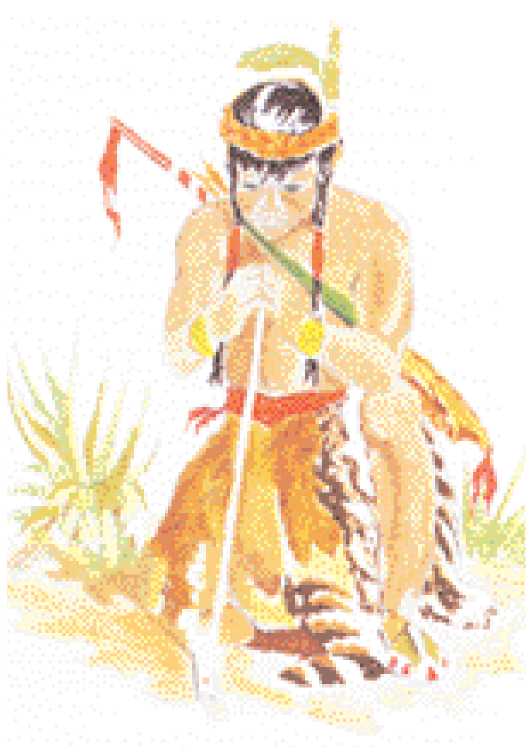The Hupa, or Hoopa, occupied ancestral territory along the Trinity River in what now is northwestern California. Their villages were located especially on an eight-mile stretch, known as the Hoopa Valley, where the Trinity River flows northwestward from the Coast Range, merging with the Klamath River flowing out of Oregon. To the north of the Hupa, along the Klamath River, lived two tribes with whom the Hupa are closely related culturally, the KAROK and YUROK. In fact, their tribal name, pronounced HOOP-uh, is taken from the Yurok name for the valley where the Hupa lived. The Hupa Native name in

Hupa purse made from an elk's antler, the incised design rubbed with pigment
Their Athapascan language is Natinook-wa from the valley, Natinook, “where the trails return.”
All three tribes shared lifeways with other CALIFOR NIA INDIANS: hunting, fishing, and gathering; the making of bread and other foods from acorns; and the crafting of finely twined basketry for storage, cooking, hats, and cradles. The three tribes also shared cultural traits with NORTHWEST COAST INDIANS living directly north of them: cedar-planked houses using pole-and-beam construction, dugout canoes, and a dependency on salmon as a staple food. In their social organization, the Hupa, like Northwest Coast peoples, defined status by material possessions. If there was a dispute or a crime between individuals, differences could be settled by paying a fine. A mediator would negotiate the amount between the opposing parties.
The three tribes all practiced annual World Renewal ceremonies. The season they were held and their length varied from group to group. For all three peoples, however, the event involved two parts: First, a shaman, who had purified himself with special rites, would lead his assistants to different locations where he performed secret rites to renew nature; then dancers performed for all the villagers. Sometimes tribe members would provide the dancers with their costumes in order to show off their wealth and their standing in the tribe.
The participants, whose numbers increased throughout the ceremonies, performed two main dances: the White Deerskin Dance and the Jumping Dance. In the former, the dancers wore animal-skin aprons, tooth-shell necklaces, and feather headdresses. They carried poles draped with deer hides, the heads of which were decorated with the red-feathered scalps of woodpeckers. Rare white deer-skins were thought to cast the greatest powers of renewal and provided the dancer and his sponsor with much prestige. In the latter ritual, the Jumping Dance, the dancers wore woodpecker scalps, fashioned into headdresses, on their own heads and carried tubular wands woven out of plant materials.
Interestingly, although all three peoples had so much in common in terms of culture, their languages differ. Different tribes in a given region typically spoke different dialects, but usually from the same language family. In this case, the Hupa are Athapascan-speaking (see ATHAPASCANS); the Karok, Hokan-speaking; and the Yurok, Algonquian-speaking. (This language discrepancy among neighboring tribes demonstrates that geography plays a more important role in determining a tribe’s culture than language does.)
Because of the isolated location of the Hoopa Valley in California’s highlands, the Hupa had few historical contacts with non-Indians. The Spanish and the Russians never colonized their domain. Occasional fur traders and trappers followed the Trinity River from the Klamath River but never established permanent posts. Some Euroameri-cans and Chinese mined the river with pans during the California gold rush of 1849, but there were not enough gold strikes to cause prospectors to overrun Hupa territory. More and more settlers arrived in the region after California statehood in 1850, but the Hupa managed to hold on to their ancestral homeland. In 1876, the federal government made Hoopa Valley a reservation.
Hupa people live in Hoopa Valley today, with members from other area tribes. The Hoopa Valley Reservation is the largest and most populous in California. Inhabitants farm, raise livestock, cut lumber, and are generally self-sufficient. They still practice traditional customs, such as hunting,

A Hupa Indian using a fire-drill (based on a cigarette silk, distributed with cigarettes as souvenirs in the early 1900s)
Fishing, acorn-gathering, basketmaking, beadwork, and the White Deerskin and Jumping dances. The ancient village of Takimildin on the reservation remains a spiritual center. Because the Hupa live where their people have always lived and because they retain many of the ancient ways, they have a strong sense of continuity with their ancestors and a sense of tribal vitality. For years the Hupa have advocated the protection of their sacred river, the Trinity, which has been dammed and rerouted. Based on the decision by the U. S. Congress that the conditions and health of a river should be monitored by its consumers, the Hupa will be involved in a restoration program to clean the river.




 World History
World History









